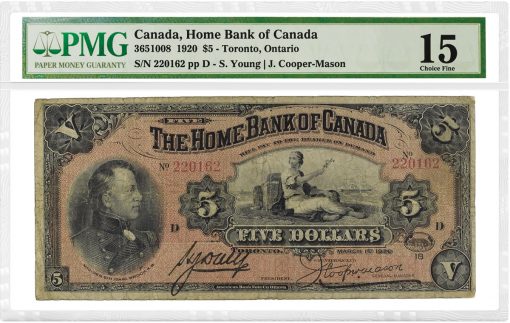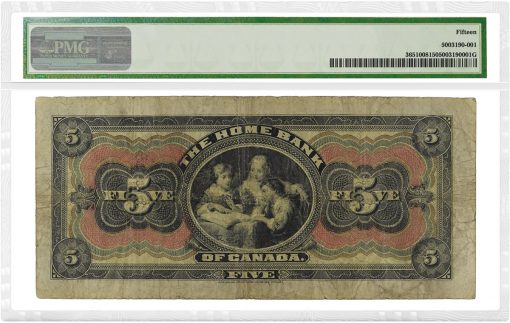Paper Money Guaranty® (PMG) has certified the second-known example of the 1920-dated Home Bank of Canada $5.

The issue was previously thought to be unique, with the only example being in the National Currency Collection of The Bank of Canada. The note, recently certified by PMG, is the first and only in private hands.
This problem-free PMG Choice Fine 15 note still retains much of the eye appeal of a VF note, exhibiting good color and bold signatures. The front of the note features a portrait of Major General Sir Isaac Brock at the left, and a seated allegorical "Commerce" portrait at the center with ships in the background. The back of the note features three students ("Mutual Improvement"), and the bank name at the center.
The Home Bank of Canada, incorporated on July 10, 1903, was a Canadian bank headquartered in Toronto that issued notes dated 1904, 1914, 1917, and 1920; in denominations of $5, $10, $20, $50, and $100. The notes were printed by the American Bank Note Company in Ottawa. It is estimated that just over 50 issued notes exist today in private hands across all denominations and dates (an additional 14 are in institutional holdings). Of all the dates, the 1920 is by far the most rare and elusive.

The rarity of The Home Bank of Canada notes today stems from the bank’s relatively short lifespan (1903-1923) that dramatically ended in failure. Ten of its officials were eventually arrested on charges ranging from fraud to authorizing false returns. It is likely that a portion of the 1920-dated series of notes were unissued and subsequently destroyed when the bank failed.
The Home Bank of Canada started life as the Toronto Savings Bank in 1854, and in 1871 became the Home Savings and Loan Company. The bank grew, and in 1903 received a Federal Charter to become The Home Bank of Canada, empowering the bank to issue its own banknotes. At its height, The Home Bank of Canada had over 70 branches and over 60,000 depositors throughout Canada.
The failure of the Home Bank of Canada was the subject of a Canadian Royal Commission initiated by Canadian Prime Minister William Lyon Mackenzie King in 1924. It was revealed that the bank president made several questionable loans to a close family friend, as well as other companies with whom he and other bank directors were closely involved.
The unpaid debts became so large that the bank felt it couldn’t afford to let them fail. The bank officers continued to approve additional funds, and the accruing interest on the bad loans was recapitalized into the principal, building the house of cards ever higher. The Board of Directors never bothered to examine the books closely and the firm’s untrained internal auditor dutifully attested to the bank’s health right up to August 17, 1923, when a white cardboard placard was nailed to the door of the head office in Toronto, hastily written with the words "Bank Closed. Payment Suspended."
At the time of failure, The Home Bank of Canada’s assets were estimated at $2.7 million against liabilities of $15.5 million. There was no federal deposit insurance in 1923, and thousands of people risked losing their entire life savings. The Home Bank’s receiver was able to recoup just 25 cents on the dollar for depositors.
Angry citizens pressured the Federal Government to provide an additional 35 cents on the dollar from a special relief fund for small depositors with accounts up to $500 (no Federal Government compensation was offered for balances above $500). Public outrage led to stricter government oversight of financial institutions, including the creation of the Office of the Inspector-General of Banks.
Canadians regard Isaac Brock as one of their greatest military heroes. Thus, picturing Brock on The Home Bank of Canada $5 was designed to instill confidence in the strength and leadership of the bank’s management. Sadly, the bank’s leadership paled in comparison to that of Brock’s! Brock was "The Hero of Upper Canada" for his exploits in the War of 1812 (1812-1815) between the United States and Great Britain.
On June 18, 1812, US President James Madison signed a declaration of war against Great Britain over, among other grievances, British violations of American maritime sovereignty rights and trade. As a colony of Great Britain, Canada was swept up in the war. Thomas Jefferson famously wrote that conquering Canada would be "a mere matter of marching". This turned out not to be the case; despite being outnumbered, Canadian forces composed of British, Canadian and First Nations members successfully repelled American invasion attempts. By the winter of 1813, the only Americans in Canada were prisoners of war.
Isaac Brock, the Commander-in-Chief of British forces in Upper Canada, was a brilliant commander who inspired the admiration and loyalty of his troops. Believing that "offence was the best defence," Brock crossed into the US and took Fort Detroit by force on August 16, 1812, diminishing American morale and strength in the area. Isaac Brock was killed by a musket ball to the chest in the Battle of Queenston Heights on October 13, 1812, and in the process became Canada’s first true hero (Brock University in St. Catharines is named after him, as are many streets).
The two sides finally tired of fighting and signed a peace treaty on Christmas Eve, 1814: The Treaty of Ghent, which essentially affirmed pre-war borders. Americans emerged from the war with new confidence in having stood strong as a nation against the military might of Great Britain.
Canadians likewise emerged from the war with new confidence in having successfully defended their land against American invasion and collectively unifying as "Canadians," rather than just a colony of Great Britain. You can thus forgive Americans and Canadians who both answer the question of who won the War of 1812 with "we did!"
Prior to the 1920-dated Home Bank of Canada $5 note being recently submitted to PMG, the National Currency Collection (NCC) of The Bank of Canada’s Museum housed the only known example.
To learn more about the 1920-dated Home Bank of Canada $5 note residing in the NCC, PMG contacted David Bergeron, the current curator of the NCC in Ottawa. He kindly shared that the note was purchased in 1974 by Sheldon Carroll (who was then the curator of the NCC) from Charlton Numismatics (the largest coin company in Canada in the 1970s). Charlton Publishing produces The Charlton Standard Catalogue of Canadian Bank Notes, where this note is listed as Charlton 365-10-08.
It is truly astonishing to find that it has been almost 50 years since Charlton Numismatics sold their 1920-dated Home Bank of Canada $5 note to the NCC, and that no other example had been discovered until this note was recently submitted to PMG for authentication and grading.
Heritage Auctions (HA.com) plans to offer this note as part of the Central States Numismatic Society auctions on April 26, 2019 in Schaumburg, IL (a suburb of Chicago). It has been an incredible privilege for PMG to be entrusted with grading such an iconic piece of Canadian history.
Founded in 2005, PMG is the world’s most comprehensive third-party paper money grading and encapsulation service. To learn more about the company and its services, visit PMG.





